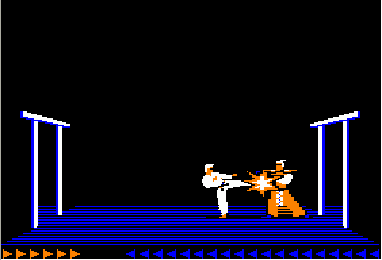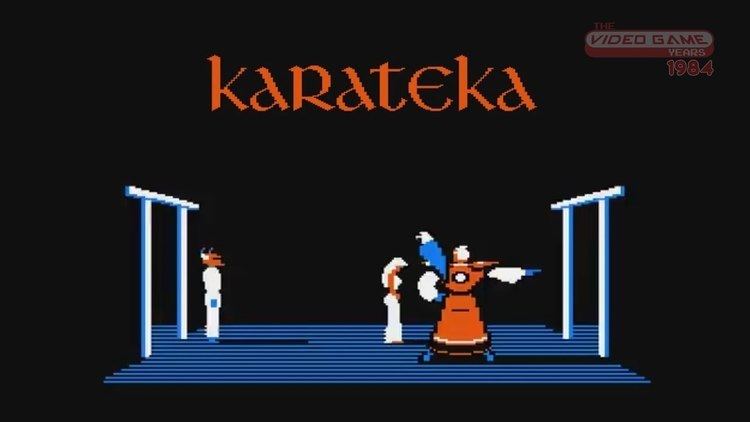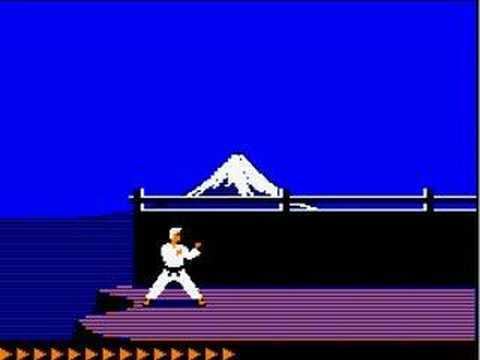8.6 /10 1 Votes8.6
| 4.3/5 Google Play Initial release date 1984 Genre Action game | |||||||||||||||||||||||||||||||||
 | ||||||||||||||||||||||||||||||||||
Release date(s) Apple IINA: 1984Atari 8-bitNA: 1985Commodore 64NA: 1985EU: 1985FamicomJP: December 5, 1985Atari 7800NA: 1988CPC, MSX, ZXEU: 1990Xbox 360WW: November 7, 2012Windows, PS3WW: November 2012iOSWW: December 2012Wii UWW: TBAClassic (Android, iOS)WW: May 16, 2013 Publishers Brøderbund Software, D3 Publisher, Atari, DROsoft, Soft Pro International Similar Jordan Mechner games, Fighting games | ||||||||||||||||||||||||||||||||||
Karateka is a 1984 martial arts action game by Jordan Mechner, and was his first published game, created while attending Yale University. It was originally programmed for the Apple II, then widely ported. The game was published in North America by Brøderbund, and in Europe by Ariolasoft. Along with Karate Champ (1984) and Yie-Ar Kung Fu (1985), Karateka was one of the earliest fighting games.
Contents

The player controls an unnamed protagonist who is attempting to rescue his love interest, the Princess Mariko, from Akuma's castle fortress. The game exhibits a combination of a side-scrolling platform and fighting game elements similar to a beat 'em up. The player uses punches and kicks to defeat Akuma and his guards and make his way deeper into the fortress.
A 2013 remake, spearheaded by Mechner, was released in 2013 as a downloadable title for the Xbox 360, Microsoft Windows, PlayStation 3 and iOS.

Gameplay
Karateka uses gameplay elements found in both side-scrolling 2D platformers and fighting games.

The player is introduced to the unnamed hero as he ascends a mountain into Akuma's fortress to rescue Princess Mariko. As the player directs the hero into the fortress, various foes appear and attempt to stop him. Once in a fighting stance, the player delivers blows, punches, and kicks at the enemy while dodging the enemy's attacks. The player's health, shown by a bar on the bottom of the screen, diminishes with every hit he takes, though health is recovered slowly by not engaging in combat. Should the player lose all his health, the game is over, requiring the player to start again. The enemy's health bar is shown on the screen as well; once this is drained, the player has defeated him and can progress forward.

In addition to human enemies, Akuma occasionally sends his trained hawk to attack the player, which can be deflected with well-timed punches. There are some environmental hazards that the player can come upon, such as a falling portcullis or an open cliffside, which end the game immediately if not avoided. Throughout the game, cut scenes are shown, displaying such scenes as Akuma ordering his men to attack the player and Mariko nervously awaiting her fate.

Eventually, the player will reach and face Akuma in a final conflict. Once Akuma is defeated, the player is able to rescue Mariko, though the player must assure that he is out of a fighting stance, or else the princess will assume he is an enemy and kill him in one blow. Once Mariko is freed, she and the player leave the fortress together.
An Easter egg is present on the Apple II floppy disk release. Though claimed to be sold as a single-sided disk, the reverse side of the disk included a full version of the game that would be rendered upside-down on the player's monitor. According to Mechner, this was done as a joke, causing naive users to call tech support and ask why the game was upside-down. Invariably, those users would receive the reply, "take the disk out, insert it right-side up, and reboot".
Development
Karateka was developed by Jordan Mechner while he was a student at Yale University as a side project between his classes. In learning to program on the Apple II, he had written a clone of Asteroids and a modified version he titled Deathbounce. He submitted Deathbounce to Brøderbund, which they declined. They provided Mechner with a copy of Choplifter, then one of the top selling games from Brøderbund. Mechner recognized from this game that he could pursue original game concepts instead of having to remake existing titles.
Using some of the graphic features that Choplifter provided, Mechner focused on a karate-themed game as a result of numerous factors which included his ongoing studies as a film student, his involvement in several film clubs at Yale, and having recently taken lessons in karate at the time. He also drew inspiration from Japanese Ukiyo-e woodblock print art, and the cinematic works of Akira Kurosawa, early Disney animated films, and silent pictures; he claimed that such works "convey such powerful emotion and atmosphere without a word being spoken". One of his goals was to combine cinematic techniques with game elements to create, at that time, a novel experience; from this, Mechner programmed some of the screen wipes used in Seven Samurai as game elements. In reflecting on the game, Mechner stated that he did not consider the game as a "fighting game", but instead that of "a story-based game where the gameplay mechanic is fighting".
Mechner wanted to create fluid animations within the Apple II's eight frames per second capacity, but this was hampered by the presence of additional on-screen elements, such as one of the palace gates. Mechner found that he could not animate and play music (limited to one-note tones) at the same time, forcing him to adapt to these limitations. To create the animations, he used rotoscoping, drawing over images taken while filming his karate instructor demonstrating various moves. Mechner credits his father with creating the music for the game. Work to complete the game took approximately two years, with Mechner submitting the game to Brøderbund during the later part of his sophomore year at Yale.
Ports
Mechner believed that Robert Cook's versions for the Commodore 64 and Atari 800 were the best ports, with some features superior to the original; Mechner's father reorchestrated his music to use the computers' improved audio. Ports to the Amstrad CPC and DOS appeared in 1986, and for the Atari 7800 in 1987, the Atari ST in 1988, and ZX Spectrum in 1990 though only released in Spain and in Spanish. The game was released in Japan for the Famicom in 1985, ported by Soft Pro. In that version, the Karateka's martial art is specified as Nanto Saishi Ken (南斗再試拳 South Dipper Retry Fist). An original Game Boy port was done under the name Master Karateka with release limited to Asia.
Reception
The game was considered a best seller in its original release in 1984, with more than 500,000 copies sold. It was Broderbund's best-selling Commodore game as of late 1987. Compute! in 1985 called Karateka "a nominee for the Most Underrated Program of the Year. It's a program that must be seen to be fully appreciated". Although the reviewer criticized the player's necessity to restart from the beginning when defeated, It stated that the Apple II version "has by far the best animation I've seen in an Apple arcade game. The smoothness of the animation ... makes the game almost as enjoyable to watch as it is to play". Antic in 1986 liked its "cartoon-quality" graphics. Although critical of the "often slow" joystick control system, the magazine concluded that Karateka was "fun and extremely addicting". According to Dragon, "this game has a great plot, animation that'll dazzle your eyes, and player-controlled martial arts action."
Modern remake
In February 2012, Mechner announced that he was leading a small independent development group to create a remake of Karateka for the Xbox 360 via Xbox Live Arcade, PlayStation 3 via PlayStation Network, and Wii U via the Nintendo eShop. Mechner anticipated a release date of late 2012, which was later announced to be November 2012. The concept for the remake came after Mechner completed work for the 2010 film The Sands of Time. He felt that he wanted to do a new project with a "guerrilla" feel and at a much smaller scale than he had experienced for the film. He also took into consideration that nearly 30 years after the game's release, he was still being asked questions about Karateka in interviews. This led Mechner to remaking Karateka which, outside of the ports near the time of its release, had not undergone a remake. He envisioned that he would be able to retell the story using modern console hardware and without the limitations of the Apple II system. Other factors leading to the remake included the resurgence of small, independent game development in 2010 and 2011, and games such as Limbo that "created a powerful emotional atmosphere within a limited budget and scope".
Mechner assembled a small independent team at Liquid Entertainment backed by angel investment, to create the remake; this smaller group allowed Mechner to be more hands-on with the game's development. The remake was designed to stay true to core game, described by Mechner as "a compact, pick-up-and-play game that is fluid, atmospheric and beautiful". Certain cinematic elements, such as being void of dialogue, remain in the remake. Mechner's team focused on improving the game's controls, making them "hard to master", and encouraging players to run through the title again to improve on their performance. During the remake's development, the team experimented with different approaches, ending up with "brand-new combat mechanics" and creating a "rhythm-based" fighter, where "you match the rhythm of your opponent’s attacks and eventually earn your counterattack".
Mechner, in anticipating frustration for younger gamers that may have not played the original game, removed the one-shot deaths present in the original that would force the player to restart the game. This is evident in the game's new approach: the player starts as Mariko's "True Love", as in the original, but should they fail in combat, they then play as a second character, a Monk. They play on from where the True Love fell, and then continue as a third character, a Brute, if the player fails again. While the player can complete the game as any of the characters, the ultimate goal is to reunite Mariko with her True Love, giving the approximate forty-minute game high replayability, according to Mechner. The game maintains the immersion as the player transitions between each character.
Mechner stated that some of the humorous additions, such as the possibility of being killed by Mariko at the end of the game, would likely be removed. This was due to his belief that "you can’t surprise people twice the same way", and led him to replace this possibility with other secrets for players to discover. Mechner's focus on keeping the game as a simple game to pick up and play led to the decision to distribute the title through downloadable game services. Comic and animation artist Jeff Matsuda was brought into the team to help with character animations, while composer Christopher Tin developed the game's dynamic score.
